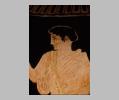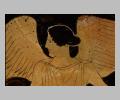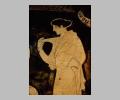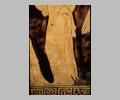| Collection: | University Museums, University of Mississippi |
| Summary: | Side A: Bride and two women |
| Ware: | Attic Red Figure |
| Painter: | Attributed to the Group of Polygnotos |
| Context: | From near Vari |
| Date: | ca. 450 BC - ca. 440 BC |
| Dimensions: | H. 0.568 m.; D. 0.239 m. |
| Shape: | Lebes gamikos |
| Region: | Attica |
| Period: | High Classical |
Condition:
Broken and mended.
Decoration Description:
The pedestal is in one piece with the vase. The lid of the vase has a high knob. At the junction of the knob and lid, and near the outer edge of the top of the lid, there is a tongue pattern. On the body of the vase, an egg pattern is used around the edge of the rim, and around the base of the handles. There is a tongue pattern on the shoulder, above the scene and between the handles, and a meander and checker-square pattern runs all around below the scene, with a ray pattern at the base. On the conical pedestal a meander and checker-square pattern is used at the top. Below this, and above the scene, is a laurel wreath to the left, between narrow reserved bands. Below the scene are rays. The lower surface of the rim is reserved.
Side A: A bride and two friends are depicted. The bride is seated in the center of the composition on a high-backed chair (klismos) with curving legs. She wears a sleeved Ionic chiton and a himation wrapped about her legs. Her hair is done up in a knot at the back and held in place by a broad taenia. She is looking at herself in a hand mirror which she holds in her right hand. At the left behind the bride stands a woman wearing a Doric peplos, belted at the waist. She stands in a frontal pose with her weight on her left leg and her right knee bent. Her head is turned toward the bride. She holds out her hands in a gesture of admiration. Facing the bride at the right stands another friend, wearing a long Ionic chiton and a himation, a fold of which she pulls over her right shoulder with her raised right hand. Toward the group, from the right, flies the Dawn Goddess, to greet the bride. She is clad in a Doric peplos, similar to that worn by the figure at the left. Similar winged figures occur on most of the known examples of lebetes gamikoi. On a pyxis in the Louvre (
Side B: The same as Side A. Here the bride is shown seated to the left, and wears her himation pulled higher over her shoulders. She holds in her right hand a small casket or chest, which has just been presented to her as a gift by the girl facing her at the left. She wears a Doric peplos and stands with her hands extended toward the bride to whom she has given the box. At the right stands an older and taller woman wearing a chiton and himation, who admires the gift. Though in a frontal position, she looks to the left and makes a gesture with her right hand toward the bride. Behind her is the hymeneal altar toward which a winged figure is flying. It is possible that the goddess is bringing the bridal veil, but it seems more likely that she is meant to be represented with her hands wrapped up inside her himation. On the wall above the bride hangs a taenia.
On the pedestal, a youth is pursuing a girl as an old man watches. The youth wears a mantle fastened at his shoulder, a petasos hanging from a cord around his neck, a wreath in his hair, and high laced sandals. He carries two spears in his right hand, and runs to the right, stretching out his left hand as though to grasp the girl by the shoulder. She wears a Doric peplos with a dark border around the bottom of the skirt and overblouse. She runs to the right, holding up her skirt with her left hand, her right arm bent and held across her breast, and her head turned back as if to ask for mercy. She is running toward an old man, probably her father, who stands at the right, leaning on a staff which he holds in his right hand. He is bearded, and wears a long chiton and himation, and a dark fillet in his white hair. To the left of the youth another woman runs away to the left, looking back at the central group. She wears a chiton and himation, and has her hair in a sakkos. In her right hand she carries a very stylized flower, in the form of palmette leaves and tendrils. Between her and the old man's back is a dolphin.
Collection History:
Gift of Mrs. Frank S. Peddle, Jr., 1960. Formerly in the D.M. Robinson collection, Harvard inv. 196. Originally purchased in Western Europe.
Sources Used:
Mississippi museum archives. A City of Images (Princeton, 1989): 89-108
Other Bibliography:
JdI XV (1900)144-154





